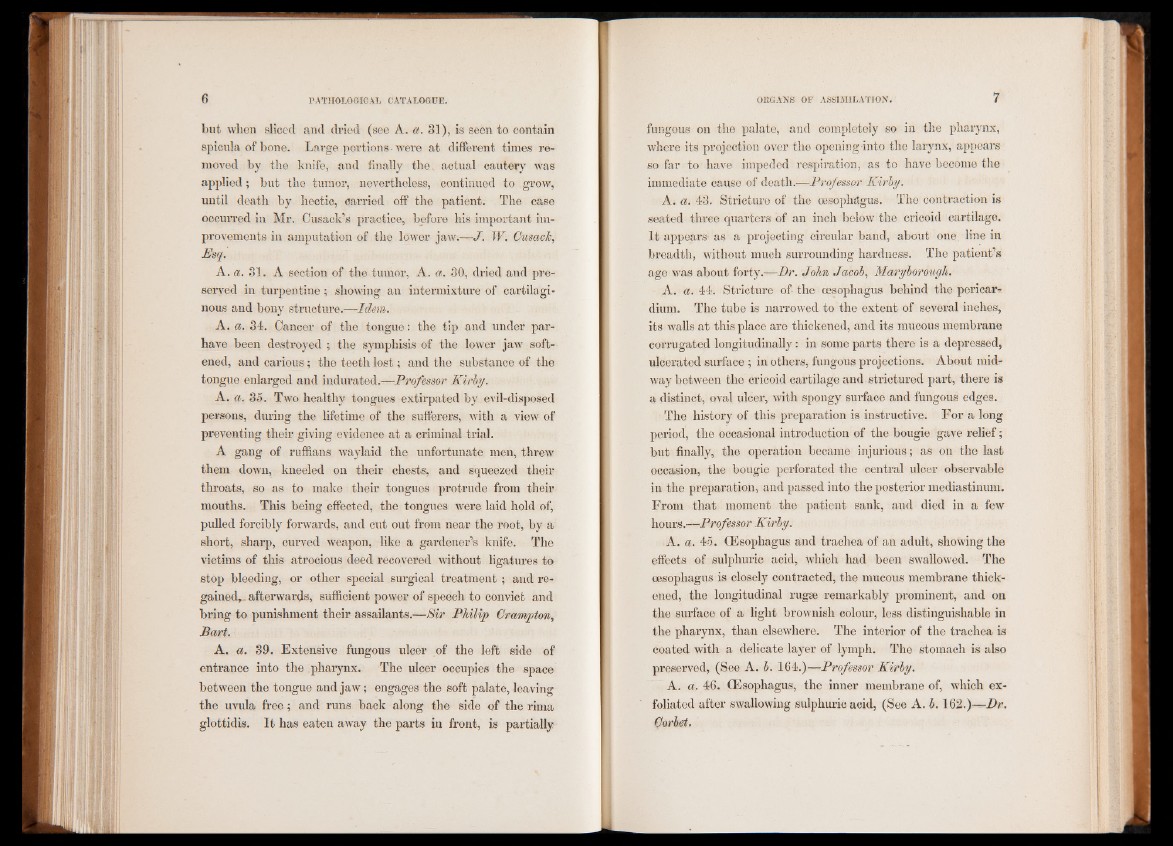
but when sliced and dried (see A. a. 31), is seen to contain
spieula of bone. Large portions -were at different times removed
by the knife, and finally the, actual cautery was
applied; but the tumor, nevertheless, continued to grow,
until death by hectic, carried off the patient. The case
oocuiTed in Mr. Cusack’s practice, before his important improvements
in amputation of the lower jaw.—J. W. Cusach,
Esq.
A. a. 31. A section of the tumor, A. a. 30, dried and preserved
in turpentine ; showing an intermixture of cartilaginous
and bony structure.—Idem.
A. a. 34. Cancer of the tongue: the tip and under par-
have been destroyed ; the symphisis of the lower jaw softened,
and carious ; the teeth lost; and the substance of the
tongue enlarged and indurated.—Professor Kirby.
A. a. 35. Two healthy tongues extirpated by evil-disposed
persons, during the lifetime of the sufferers, with a view of
preventing their giving evidence at a criminal trial.
A gang of ruffians waylaid the unfortunate men, threw
them down, kneeled on their chests, and squeezed their
throats, so as to make their tongues protrude from their
mouths. This being effected, the tongues were laid hold of,
pulled forcibly forwards, and cut out from near the root, by a
short, sharp, curved weapon, like a gardener’s knife. The
victims of this atrocious deed recovered without ligatures to
stop bleeding, or other special surgical treatment ; and regained,.
afterwards, sufficient power of speech to convict and
bring to punishment their assailants.—Sir Philip Crampton,
Part.
A. a. 39. Extensive fungous ulcer of the left side of
entrance into the pharynx. The ulcer occupies the space
between the tongue and jaw; engages the soft palate, leaving
the uvula free; and runs back along the side of the rima
glottidis. It has eaten away the parts in front, is partially
fungous on the palate, and completely so in the pharynx,
where its projection over the opening into the larynx, appears
so far to have impeded respiration, as to have become the
immediate cause of death.—Professor Kirby.
A. a. 43. Stricture of the oesophagus. The contraction is
seated three quarters of an inch below the cricoid cartilage.
It appears as a projecting circular band, about one line in
breadth, without much surrounding hardness. The patient’s
age was about forty.—Dr. John Jacob, Maryborough.
A. a. 44. Stricture of the oesophagus behind the pericardium.
The tube is narrowed to the extent of several inches,
its walls at this place are thickened, and its mucous membrane
corrugated longitudinally: in some parts there is a depressed,
ulcerated surface ; in others, fungous projections. About midway
between the cricoid cartilage and strictured part, there is
a distinct, oval ulcer, with spongy surface and fungous edges.
The history of this preparation is instructive. For a long
period, the occasional introduction of the bougie gave relief ;
but finally, the operation became injurious; as on the last
occasion, the bougie perforated the central ulcer observable
in the preparation, and passed into the posterior mediastinum.
From that moment the patient sank, and died in a few
hours.—Professor Kirby.
A. a. 45. CEsophagus and trachea of an adult, showing the
effects of sulphuric acid, which had been swallowed. The
oesophagus is closely contracted, the mucous membrane thickened,
the longitudinal rugae remarkably prominent, and on
the surface of a light brownish colour, less distinguishable in
the pharynx, than elsewhere. The interior of the trachea is
coated with a delicate layer of lymph. The stomach is also
preserved, (See A. b. 164.)—Professor Kirby.
A. a. 46. CEsophagus, the inner membrane of, which exfoliated
after swallowing sulphuric acid, (See A. b. 162.)—Dr.
Corbet.